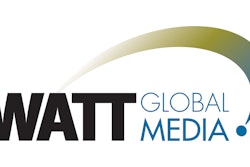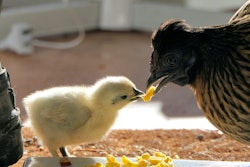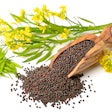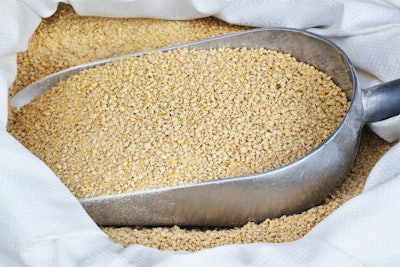
Despite ongoing volatility, optimism fuels the poultry and feed industries in 2024. Biosecurity and proactive sustainability measures take center stage, shaping investments and long-term plans. While raw material costs remain a top concern, producers explore innovative feed additives and embrace antibiotic reduction strategies, navigating production challenges with cautious optimism.
WATT Global Media’s annual Poultry Nutrition & Feed Survey offers a firsthand look at the trends affecting the poultry industry worldwide and provides a glimpse into the ways poultry producers, nutritionists and feed manufacturers are adapting.
The 2024 edition of the global survey includes input from 326 respondents. More than half of survey participants are nutritionists, consultants and veterinarians; 20% work in live production management or own a poultry farm.
Despite high inflation and continuing geopolitical friction, survey respondents were optimistic about the year ahead, with 36% predicting their feed production will increase in 2024 or at least stay the same (38%). Biosecurity and proactively evaluating their environmental footprint have risen in importance, steering capital invests and long-term planning.

In 2024, more than 50% of survey respondents are optimistic about their company’s 2023 profitability, up 5% from last year’s survey. (WATT Global Media)
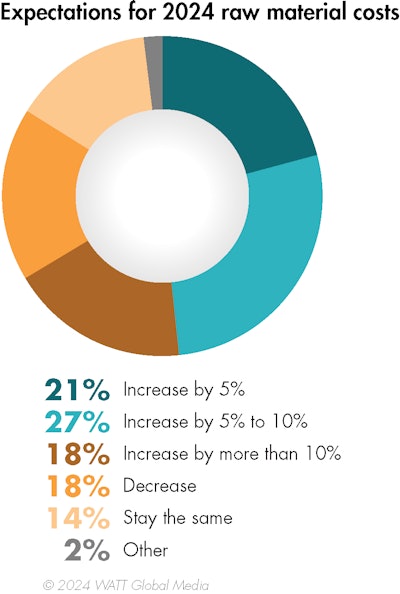
Input price volatility carries into 2024, with respondents estimating their costs to increase by between 5% to 10% (27%) or to exceed 10% (18%). Yet, another 18% report reduction in ingredient costs this year. (WATT Global Media)
2024 profitability outlook
Compared with 2023’s survey results, 2024’s survey respondents seem to have a more optimistic business outlook. Fifty-five percent believe their company’s profitability will improve in 2024, 33% predict it will remain flat and 14% feel it will deteriorate.
Poultry and poultry feed producers weathered commodity price volatility of the past few years, a trend that continues into 2024. When asked to weigh in on the primary challenges facing their business, 83% cited the cost of raw materials as their No. 1 challenge: 18% fear they will increase by more than 10% this year and 27% of survey respondents anticipate their grain costs increasing by between 5% to 10%. Respondents also acknowledge rising feed additive and micro-ingredient prices (61%) and availability (60%) will continue to challenge their operations.
Meanwhile, 15% believe their feed ingredient prices will stay the same as 2023, and an optimistic 18% forecast decreases.
High energy and transportation costs (68%) ranked among producers’ top concerns. Unlike the three surveys since the COVID-19 pandemic, supply chain disruptions did not rank as a Top 5 concern.
High interest rates aside, 38% poultry and feed companies are investing in upgrades to improve biosecurity. In the wake of devastating highly pathogenic avian influenza (HPAI) losses (22%), 49% of respondents share that their company has altered its biosecurity procedures in 2023-24 because of the disease. In addition, HPAI influenced the forecasts and business decisions made by 45% of respondents. Fifteen percent report that HPAI will decrease their feed production by between 10% and 50%.
Thirty percent plan to upgrade their feed mills and purchase new manufacturing or processing equipment — with 14% breaking ground on greenfield facility construction.
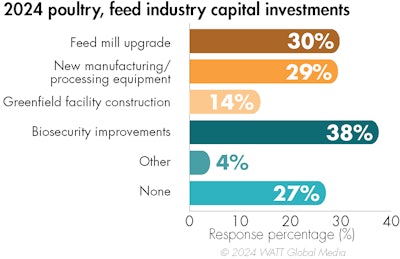
Poultry and feed companies plan to invest in biosecurity and feed mill upgrades in 2024. (WATT Global Media)
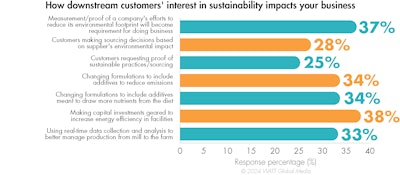
Making capital investments geared to increase energy efficiency in facilities and measurement/proof of a company’s efforts to reduce its environmental footprint will become a requirement for doing business. (WATT Global Media)
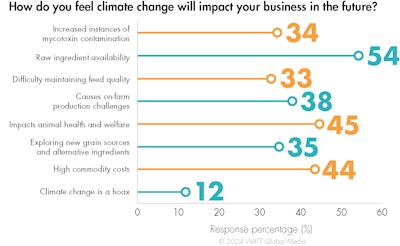
Survey respondents believe climate change will affect feed production by decreasing raw material availability, animal health and wellness and high commodity costs. (WATT Global Media)
Sustainability, climate shape production
Sustainability and what it means for feed and poultry producers remains a hot topic moving into 2024. When asked how this emphasis on reducing greenhouse gas emissions and limiting environmental impacts will influence their business in 2024, 34% of survey respondents say they have changed their formulations to include additives meant to draw more nutrients from rations, and 34% have begun including emission-reducing feed additives to their feeding programs.
On the manufacturing front, companies have also started making a concerted effort to improve energy efficiency in their operations (38%) and utilizing real-time data collection and analysis to better manage production (33%).
Looking ahead, 37% of respondents believe measurement and proof of efforts to reduce one’s environmental footprint will be a requirement for doing business.
Citing the pressure of downstream customers, 28% are making sourcing decisions based on perceived environmental impact of their suppliers; 25% report they have requested proof of sustainable practices and sourcing.
In 2024, survey respondents acknowledge the effects of climate change and how it will eventually impact their business. In the future, survey respondents believe climate change will be responsible for affecting raw material availability (54%), animal health and welfare (45%), high commodity costs (44%), and contribute to on-farm production challenges (38%).
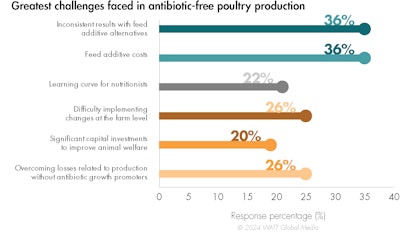
Tied for No.1 for a second year, respondents continue to point to inconsistent results from feed additive alternatives and their high costs as a consistent challenge for poultry producers who have reduced or eliminated their antibiotic usage. (WATT Global Media)
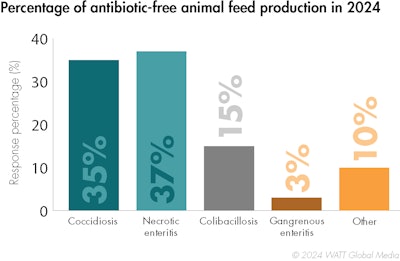
Once antibiotics were reduced or eliminated from production, 37% of respondents report heightened incidents of necrotic enteritis and coccidiosis (35%) and in their flocks. (WATT Global Media)
Antibiotic reduction, elimination challenges
Asked to identify which poultry production trends will have the greatest impact on their feed costs and formulation programs, 20% of respondents cited antibiotic restrictions as their greatest production challenge in 2024 (down 10% from 2023), followed by HPAI (15%), sustainability measures (13%) and slow-growing chicken production (11%).
Eighty-three percent of 2024 survey participants report having some degree of antibiotic-free (ABF) production in their poultry operations — with 34% stating that 100% of their production is ABF.
According to respondents, the greatest challenges making the transition to ABF poultry production can be attributed to the inconsistent results they have experienced with feed additives alternatives (36%), the cost of feed additives (36%), losses related to the elimination of antibiotic growth promoters (AGP) (26%) and the difficulty implementing changes on the farm level (26%).
Since eliminating or reducing antibiotic usage in poultry feed production, respondents cite increased incidents of necrotic enteritis (37%), coccidiosis (35%) and colibacillosis (15%).
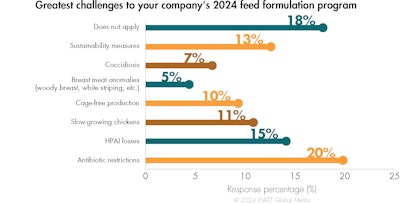
Antibiotic reduction and elimination efforts continue to be the No. 1 production trend to challenge feeding programs. (WATT Global Media)
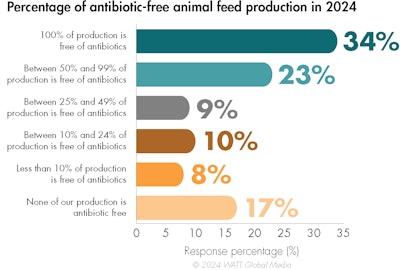
Thirty-four percent of respondents report their operation(s) being 100% antibiotic free; 23% say between 50% and 99% of their poultry production is free of antibiotics. (WATT Global Media)
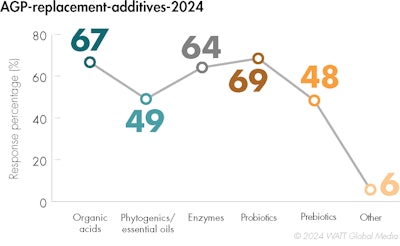
Survey respondents report utilizing and/or combining probiotics (69%), organic acids (67%) and enzymes (64%) to replace AGPs. (WATT Global Media)
Additive alternatives in post-AGP production
Most of the survey respondents (70%) report that their company is actively exploring, testing or using feed additives as antibiotic alternatives or replacements.
To regain the enhanced performance provided by AGPs, respondents have incorporated different feed additives into their rations to bridge the gap. Probiotics (69%) and organic acids (67%) ranked as the most popular AGP alternatives, followed by enzymes (64%) and phytogenic feed additives (49%).
Respondents found probiotics (82%), organic acids (79%) and enzymes (75%) to be the most effective feed additive alternatives to antibiotics. Prebiotics (68%) and yeasts (58%) also show promise. Phytogenic feed additives and essential oils were deemed effective by 60% of respondents. Many respondents report no experience with or knowledge of how to leverage the benefits of functional fibers (40%) and yeasts (30%) in ABF programs.
Comparing their outlook for 2024 inclusions against 2023, respondents will increase their use of probiotics (64%), prebiotics (59%), phytogenics (47%) and yeast cell wall products (42%) this year.
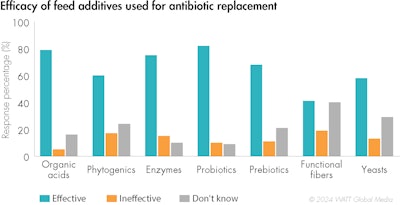
Probiotics, organic acids and enzymes — when used alone or combination with other additives — rank highly as effective solutions in antibiotic-free diets. (WATT Global Media)

Survey respondents will increase their use of probiotics (64%) and prebiotics (59%) in 2024. (WATT Global Media)
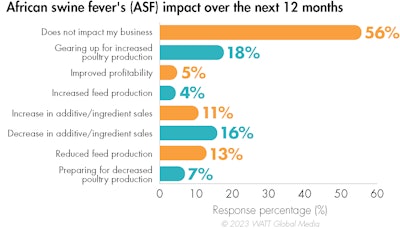
While African swine fever (ASF) does not threaten the businesses of more than half of our respondents, it influences their operations in other ways. Eighteen percent of survey respondents are planning for increased poultry production in 2024 and increased additive sales (11%). On the flip side, other respondents expect decreased feed production (13%) and additive/ingredient sales (16%). (WATT Global Media)
POULTRY NUTRITION & FEED SURVEY AT A GLANCE
The 2024 Poultry Nutrition & Feed Survey includes input from 326 poultry and feed industry stakeholders worldwide. This WATT Global Media special report seeks to identify the feeding and external trends shaping these sectors during the past 12 months; it was conducted in English and Spanish.
Participants included:
Nutritionists: 23%
Veterinarians: 14%
Consultants: 14%
Quality control, purchasing agent, other: 10%
Poultry farm owner/grower: 13%
Marketing and sales: 7%
Live production management: 7%
General administration: 7%
Feed mill/plant operations: 5%
Responses from:
United States/Canada: 29%
Mexico/Latin America: 20%
Asia/Pacific: 19%
Europe: 16%
Africa: 11%
Middle East: 5%
Sectors:
Consultant/veterinarian/nutritionist: 43%
Broiler production: 12%
Manufacturing/distributing feed additives: 10%
Feed manufacturing: 9%
Egg production: 8%
Breeder farm/hatchery: 4%
Premix manufacturing: 3%
Turkey production: 3%
Poultry processing: 3%
Other: 5%

